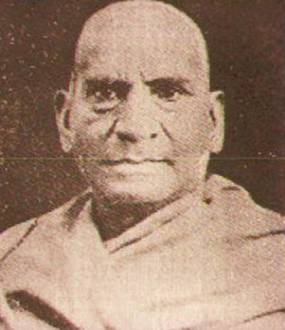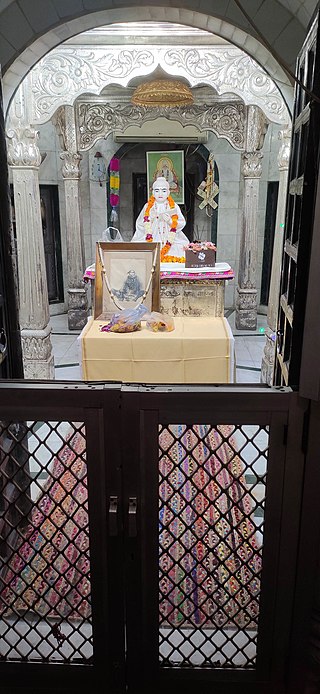
Kabir (1398–1518) was a 15th-century Indian mystic poet and saint. His writings influenced Hinduism's Bhakti movement, and his verses are found in Sikhism's scripture Guru Granth Sahib, the Satguru Granth Sahib of Saint Garib Das, and Kabir Sagar.

The Mevlevi Order or Mawlawiyya is a Sufi order that originated in Konya and which was founded by the followers of Jalaluddin Muhammad Balkhi Rumi, a 13th-century Persian poet, Sufi mystic, and Islamic theologian. The Mevlevis are also known as the "whirling dervishes" due to their famous practice of whirling while performing dhikr. Dervish is a common term for an initiate of the Sufi path; whirling is part of the formal sema ceremony and the participants are properly known as semazens.
Hindi literature includes literature in the various Hindi languages which have different writing systems. Earliest forms of Hindi literature are attested in poetry of Apabhraṃśa like Awadhi, Magadhi, Ardhamagadhi and Marwari languages. Hindi literature is composed in three broad styles- गद्य (Gadya-prose), पद्य( Padya- poetry) and चम्प्पू In terms of historical development, it is broadly classified into five prominent forms (genres) based on the date of production. They are:
Contemporary Sant Mat Movements, mostly among the Radha Soami tradition, are esoteric philosophy movements active in the United States, Europe, Australia, Latin America, and especially India. These movements assert that Sant Mat shares a lineage with Sikhism and contains elements of thought found in Hinduism, such as karma and reincarnation. They further assert that Sant Mat also contains elements found in Sufism and has inspired and influenced a number of religious groups and organizations. They refer to this spiritual path as the "Science of the Soul" or ‘Sant Mat’, meaning ‘teachings of the saints’. More recently it has been described as "The Way of Life" or "Living the Life of Soul." It incorporates a practical yoga system known as Surat Shabd Yoga.

Jessica Lal was a model in New Delhi who was working as a celebrity barmaid at a crowded socialite party when she was shot dead at around 2.00am on 30 April 1999. Dozens of witnesses pointed to Siddharth Vashisht, also known as Manu Sharma, the son of Venod Sharma, a wealthy and influential Congress-nominated Member of Parliament from Haryana, as the murderer. Manu Sharma was later convicted for the murder and sentenced to life, but released less than a year later.
Bhagat Sain was a Hindu and Sikh religious figure lived in the end of the fourteenth and the beginning of the fifteenth century. His name was known in every house due to his devotion to god. Bhagat Sain was a barber of the royal court of Raja Ram, king of Rewa. He was a disciple of Swami Ramanand.
Niranjana, also rendered Niranjan, is an epithet in Hinduism. It is a title of Krishna according to the Bhagavad Gita, and is also an epithet of Shiva.
Rakhi Aur Hathkadi is a Hindi film that was released in 1972. It was directed by S. M. Sagar. It stars Ashok Kumar, Asha Parekh in a dual role, Vijay Arora, Danny Denzongpa, Kabir Bedi, and Helen. Music is by R.D. Burman. Lyrics are by Majrooh Sultanpuri. Asha Bhosle sang all seven songs, two of which were duets with Kishore Kumar.

Swami Shraddhanand, also known as Mahatma Munshi Ram Vij, was an Arya Samaj sannyasi and an Indian Independence activist who propagated the teachings of Dayananda Saraswati. This included the establishment of educational institutions, like the Gurukul Kangri University, and played a key role on the Sangathan and the Shuddhi (purification), a Hindu reform movement in the 1920s.

Shiv Brat Lal Varman, (1860-1939) popularly known by the honorifics "Data Dayal" (Merciful) and "Maharishi", was born in Bhadohi district of Uttar Pradesh state in India in February 1860. He was a post graduate and a famous writer. It is believed that he wrote as many as 3,000 books on various social, historical, religious and spiritual topics. Being a famous writer he was called as the modern Maharishi Ved Vyas and hence became famous with the name Maharishi ji.

Saint Garibdas Ji Maharaj was a spiritual leader and reformer. He took birth in 1717 A.D. to a family of Dhankhar jats in the village Chudani, District Jhajjar, Haryana, India. He was a rich farmer. According to his own account, his spiritual journey started when "Almighty God" Kabir came to meet him and gave him initiation at the age of 10 years. After getting spiritual awareness from "Almighty God Kabir", he uttered many Banis that are collected as holy book Garib Das ki Granth. Garibdas Panth is also a Kabirpanth. Saint Garib Das Ji told through his Banis that Kabir Sahib is the supreme God in Satlok. Garibdas died in 1778 A.D., and over his remains, a memorial was established.

Baba Faqir Chand, was an Indian master of Surat Shabd Yoga, or consciously controlled near death experience. He was one of the first saints or gurus of Sant Mat tradition to openly speak and write against the deceptive and harmful practices of modern guruism and religious intolerance. As a highly pragmatic individual, Faqir also strove to explain the various practices and principles of Sant Mat based on his own experiences and in the context of modern science and psychology. He was also the first Sant Mat guru to talk about the phenomena consisting of a believer experiencing a subjective projection of a sacred or holy form of a guru or idol without the conscious knowledge of the person at the center of the experience, i.e., the guru. This was termed the 'Chandian Effect', and described by researcher David C. Lane. Faqir Chand claimed that he had no knowledge of his form manifesting before a person and helping them with their worldly or spiritual problems. He fervently expressed that in his experience, the real helper is one's own true self and faith. Mark Juergensmeyer, another researcher on new religious movements, intrigued by the uniqueness of Faqir Chand's experiences, also interviewed him. This insightful interview was included in Faqir's autobiography.

Munshi Ram, Indian spiritual guru and follower of Faqir Chand.

Manavta Mandir or Be Human Temple in Hoshiarpur, Punjab, India, was established in 1962 by Baba Faqir Chand (1886–1981). In order to carry forward the mission of his religion of humanity, Faqir, with the financial help from Seth Durga Das established the temple which remained his center of activity till he died in 1981. The temple houses a statue of his guru, Shiv Brat Lal and portraits of other prominent gurus of Sant Mat, Radha Soami Mat and Sufi Mat.

Vijay Kumar Chopra is the chief executive officer and editor in chief of the Punjab Kesari print news organisation. He is involved in social welfare work and has received a Padma Shri award. In August 2009, he was elected by the Chairman of the Press Trust of India.

Rampal is an Indian religious cult leader of the Kabir Panth religious domination. Rampal is currently in jail.
Munshi Mohammad Meherullah was a Bengali Islamic scholar, poet and social reformer. He is best known for his oratory and writing on Islam and comparative religion and his efforts against anti-Islamic views expounded by Christian missionaries in India.
Rani Lila Ramkumar Bhargava was an Indian freedom fighter, social worker, educationist and a former leader of the Indian National Congress. She was an associate of Indian prime minister, Indira Gandhi and was married into the family of Munshi Nawal Kishore, the founder of reportedly the oldest printing press in Asia, Nawal Kishore Press, to Munshi Ramkumar Bhargava, a fourth generation member of the family and the holder of the title of Raja from Lord Wavell, then Viceroy of India,
Kabir Jayanti, also known as Kabir Praakat Diwas, is celebrated to commemorate the manifestation of Kabir, a famous poet and mystic saint in India. It is celebrated once in a year on the full moon day in the Hindu month Jyeshtha, which is the month of May or June according to the Gregorian calendar. Worshipers believe that Kabir was born on this day in the year 1398 A.D. Kabir Jayanti was celebrated on 24 June in 2021 and the 2022 date will be 14 June.
The Maghar Mahotsav, is an annual cultural festival, held in Maghar, Uttar Pradesh, India in memory of famous saint Kabir. It is held every year in January. Mahotsav is organized in collaboration with the Department of Tourism (UP), Department of Culture (UP) and District Administration of Sant Kabir Nagar.










